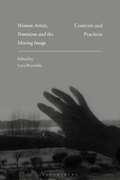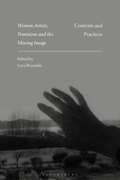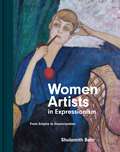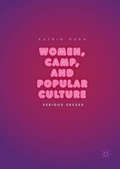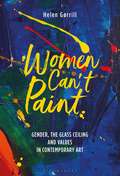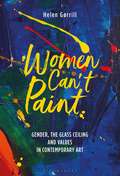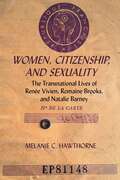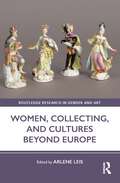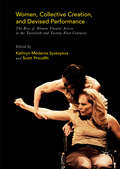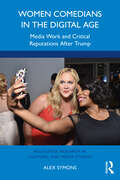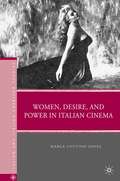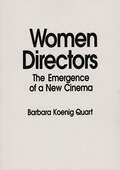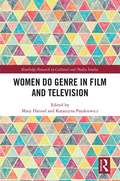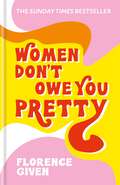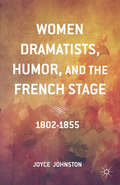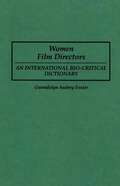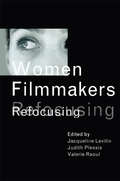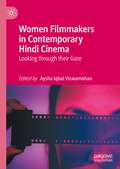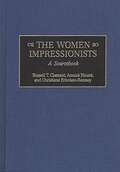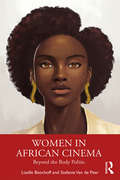- Table View
- List View
Women Artists, Feminism and the Moving Image: Contexts and Practices (International Library Of The Moving Image Ser.)
by Lucy ReynoldsWhat is the significance of gendered identification in relation to artists' moving image? How do women artists grapple with the interlinked narratives of gender discrimination and gender identity in their work? In this groundbreaking book, a diverse range of leading scholars, activists, archivists and artists explore the histories, practices and concerns of women making film and video across the world, from the pioneering German animator Lotte Reiniger, to the influential African American filmmaker Julie Dash and the provocative Scottish contemporary artist Rachel Maclean. Opening with a foreword from the film theorist Laura Mulvey and a poem by the artist film-maker Lis Rhodes, Women Artists, Feminism and the Moving Image traces the legacies of early feminist interventions into the moving image and the ways in which these have been re-configured in the very different context of today. Reflecting and building upon the practices of recuperation that continue to play a vital role in feminist art practice and scholarship, essays discuss topics such as how multiculturalism is linked to experimental and activist film history, the function and nature of the essay film, feminist curatorial practices and much more. This book transports the reader across diverse cultural contexts and geographical contours, addressing complex narratives of subjectivity, representation and labour, while juxtaposing cultures of film, video and visual arts practice often held apart. As the editor, Lucy Reynolds, argues: it is at the point where art, moving image and feminist discourse converge that a rich and dynamic intersection of dialogue and exchange opens up, bringing to attention practices which might fall outside their separate spheres, and offering fresh perspectives and insights on those already established in its histories and canons.
Women Artists, Feminism and the Moving Image: Contexts and Practices
What is the significance of gendered identification in relation to artists' moving image? How do women artists grapple with the interlinked narratives of gender discrimination and gender identity in their work? In this groundbreaking book, a diverse range of leading scholars, activists, archivists and artists explore the histories, practices and concerns of women making film and video across the world, from the pioneering German animator Lotte Reiniger, to the influential African American filmmaker Julie Dash and the provocative Scottish contemporary artist Rachel Maclean. Opening with a foreword from the film theorist Laura Mulvey and a poem by the artist film-maker Lis Rhodes, Women Artists, Feminism and the Moving Image traces the legacies of early feminist interventions into the moving image and the ways in which these have been re-configured in the very different context of today. Reflecting and building upon the practices of recuperation that continue to play a vital role in feminist art practice and scholarship, essays discuss topics such as how multiculturalism is linked to experimental and activist film history, the function and nature of the essay film, feminist curatorial practices and much more. This book transports the reader across diverse cultural contexts and geographical contours, addressing complex narratives of subjectivity, representation and labour, while juxtaposing cultures of film, video and visual arts practice often held apart. As the editor, Lucy Reynolds, argues: it is at the point where art, moving image and feminist discourse converge that a rich and dynamic intersection of dialogue and exchange opens up, bringing to attention practices which might fall outside their separate spheres, and offering fresh perspectives and insights on those already established in its histories and canons.
Women Artists in Expressionism: From Empire to Emancipation
by Shulamith BehrA beautifully illustrated examination of the women artists whose inspired search for artistic integrity and equality influenced Expressionist avant-garde cultureWomen Artists in Expressionism explores how women negotiated the competitive world of modern art during the late Wilhelmine and early Weimar periods in Germany. Their stories challenge predominantly male-oriented narratives of Expressionism and shed light on the divergent artistic responses of women to the dramatic events of the early twentieth century.Shulamith Behr shows how the posthumous critical reception of Paula Modersohn-Becker cast her as a prime agent of the feminization of the movement, and how Käthe Kollwitz used printmaking as a vehicle for technical innovation and sociopolitical commentary. She looks at the dynamic relationship between Marianne Werefkin and Gabriele Münter, whose different paths in life led them to the Blaue Reiter, a group of Expressionist artists that included Wassily Kandinsky and Paul Klee. Behr examines Nell Walden’s role as an influential art dealer, collector, and artist, who promoted women Expressionists during the First World War, and discusses how Dutch artist Jacoba van Heemskerck’s spiritual abstraction earned her the status of an honorary German Expressionist. She demonstrates how figures such as Rosa Schapire and Johanna Ey contributed to the development of the movement as spectators, critics, and collectors of male avant-gardism.Richly illustrated, Women Artists in Expressionism is a women-centered history that reveals the importance of emancipative ideals to the shaping of modernity and the avant-garde.
Women, Camp, and Popular Culture: Serious Excess
by Katrin HornThis innovative study claims camp as a critical, yet pleasurable strategy for women’s engagement with contemporary popular culture as exemplified by 30 Rock or Lady Gaga. In detailed analyses of lesbian cinema, postfeminist TV, and popular music, the book offers a novel take on its subject. It defines camp as a unique mode of detached attachment, which builds on affective intensity and emotional investment, while strongly encouraging a critical edge.
Women, Camp, and Popular Culture: Serious Excess
by Katrin HornThis innovative study claims camp as a critical, yet pleasurable strategy for women’s engagement with contemporary popular culture as exemplified by 30 Rock or Lady Gaga. In detailed analyses of lesbian cinema, postfeminist TV, and popular music, the book offers a novel take on its subject. It defines camp as a unique mode of detached attachment, which builds on affective intensity and emotional investment, while strongly encouraging a critical edge.
Women Can't Paint: Gender, the Glass Ceiling and Values in Contemporary Art
by Helen GorrillIn 2013 Georg Baselitz declared that 'women don't paint very well'. Whilst shocking, his comments reveal what Helen Gørrill argues is prolific discrimination in the artworld. In a groundbreaking study of gender and value, Gørrill proves that there are few aesthetic differences in men and women's painting, but that men's art is valued at up to 80 per cent more than women's. Indeed, the power of masculinity is such that when men sign their work it goes up in value, yet when women sign their work it goes down. Museums, the author attests, are also complicit in this vicious cycle as they collect tokenist female artwork which impinges upon its artists' market value. An essential text for students and teachers, Gørrill's book is provocative and challenges existing methodologies whilst introducing shocking evidence. She proves how the price of being a woman impacts upon all forms of artistic currency, be it social, cultural or economic and in the vanguard of the 'Me Too' movement calls for the artworld to take action.
Women Can't Paint: Gender, the Glass Ceiling and Values in Contemporary Art
by Helen GorrillIn 2013 Georg Baselitz declared that 'women don't paint very well'. Whilst shocking, his comments reveal what Helen Gørrill argues is prolific discrimination in the artworld. In a groundbreaking study of gender and value, Gørrill proves that there are few aesthetic differences in men and women's painting, but that men's art is valued at up to 80 per cent more than women's. Indeed, the power of masculinity is such that when men sign their work it goes up in value, yet when women sign their work it goes down. Museums, the author attests, are also complicit in this vicious cycle as they collect tokenist female artwork which impinges upon its artists' market value. An essential text for students and teachers, Gørrill's book is provocative and challenges existing methodologies whilst introducing shocking evidence. She proves how the price of being a woman impacts upon all forms of artistic currency, be it social, cultural or economic and in the vanguard of the 'Me Too' movement calls for the artworld to take action.
Women, Citizenship, and Sexuality: The Transnational Lives of Renée Vivien, Romaine Brooks, and Natalie Barney
by Melanie HawthorneUntil well into the twentieth century, the claims to citizenship of women in the US and in Europe have come through men (father, husband); women had no citizenship of their own. The case studies of three expatriate women (Renée Vivien, Romaine Brooks, and Natalie Barney) illustrate some of the consequences for women who lived independent lives. To begin with, the books traces the way that ideas about national belonging shaped gay male identity in the nineteenth century, before showing that such a discourse was not available to women and lesbians, including the three women who form the core of the book. In addition to questions of sexually non-conforming identity, women's mediated claim to citizenship limited their autonomy in practical ways (for example, they could be unilaterally expatriated). Consequently, the situation of the denizen may have been preferable to that of the citizen for women who lived between the lines. Drawing on the discourse of jurisprudence, the history of the passport, and original archival research on all three women, the books tells the story of women's evolving claims to citizenship in their own right.
Women, Collecting, and Cultures Beyond Europe (Routledge Research in Gender and Art)
by Leis ArleneThis book examines collecting around the world and how women have participated in and formed collections globally. The edited volume builds on recent research and offers a wider lens through which to examine and challenge women’s collecting histories. Spanning from the seventeenth century to the twenty-first (although not organized chronologically) the research herein extends beyond European geographies and across time periods; it brings to light new research on how artificiallia and naturallia were collected, transported, exchanged, and/or displayed beyond Europe. Women, Collecting and Cultures Beyond Europe considers collections as points of contact that forged transcultural connections and knowledge exchange. Some authors focus mainly on collectors and what was collected, while others consider taxonomies, travel, patterns of consumption, migration, markets, and the after life of things. In its broad and interdisciplinary approach, this book amplifies women’s voices, and aims to position their collecting practices toward new transcultural directions, including women’s relation to distinct cultures, customs, and beliefs as well as exposing the challenges women faced when carving a place for themselves within global networks. This study will be of interest to scholars working in collections and collecting, conservation, museum studies, art history, women’s studies, material and visual cultures, Indigenous studies, textile histories, global studies, history of science, social and cultural histories.
Women, Collecting, and Cultures Beyond Europe (Routledge Research in Gender and Art)
by Arlene LeisThis book examines collecting around the world and how women have participated in and formed collections globally. The edited volume builds on recent research and offers a wider lens through which to examine and challenge women’s collecting histories. Spanning from the seventeenth century to the twenty-first (although not organized chronologically) the research herein extends beyond European geographies and across time periods; it brings to light new research on how artificiallia and naturallia were collected, transported, exchanged, and/or displayed beyond Europe. Women, Collecting and Cultures Beyond Europe considers collections as points of contact that forged transcultural connections and knowledge exchange. Some authors focus mainly on collectors and what was collected, while others consider taxonomies, travel, patterns of consumption, migration, markets, and the after life of things. In its broad and interdisciplinary approach, this book amplifies women’s voices, and aims to position their collecting practices toward new transcultural directions, including women’s relation to distinct cultures, customs, and beliefs as well as exposing the challenges women faced when carving a place for themselves within global networks. This study will be of interest to scholars working in collections and collecting, conservation, museum studies, art history, women’s studies, material and visual cultures, Indigenous studies, textile histories, global studies, history of science, social and cultural histories.
Women, Collective Creation, and Devised Performance: The Rise of Women Theatre Artists in the Twentieth and Twenty-First Centuries
by Kathryn Mederos Syssoyeva Scott ProudfitThis book explores the role and centrality of women in the development of collaborative theatre practice, alongside the significance of collective creation and devising in the development of the modern theatre. Tracing a web of women theatremakers in Europe and North America, this book explores the connections between early twentieth century collective theatre practices such as workers theatre and the dramatic play movement, and the subsequent spread of theatrical devising. Chapters investigate the work of the Settlement Houses, total theatre in 1920s’ France, the mid-century avant-garde and New Left collectives, the nomadic performances of Europe’s transnational theatre troupes, street-theatre protests, and contemporary devising. In so doing, the book further elucidates a history of modern theatre begun in A History of Collective Creation (2013) and Collective Creation in Contemporary Performance (2013), in which the seemingly marginal and disparate practices of collective creation and devising are revealed as central—and women theatremakers revealed as progenitors of these practices.
Women Comedians in the Digital Age: Media Work and Critical Reputations After Trump (Routledge Research in Cultural and Media Studies)
by Alex SymonsThis book offers a thorough examination of digital work by women comedians in the US, exploring their use of digital media to perform jokes, engage with fans, remake their reputations, and become political activists. This book argues that despite its many adverse effects, digital work is changing comedy, empowering women to create new comic forms and negotiate the contentious political climate incited by former President Donald. J. Trump. Chapters are focused on video podcasting, TikTok, Twitter, Instagram, YouTube, and the streaming platform Netflix – each containing informative case studies on significant women comedians who use them, including Sarah Silverman, Amy Schumer, Leslie Jones, Mindy Kaling, Colleen Ballinger, Lilly Singh, Ms. Pat, Whitney Cummings, Issa Rae, and others. To understand their strategies, this book examines the popularity of their digital content, their career outcomes in television and film, as well as the ups and downs of their critical reputations in magazines, newspapers, the trade press, and with their participatory audiences online. This insightful and timely work will appeal to scholars researching and teaching in the areas of media studies, digital communication, gender studies, and performance.
Women Comedians in the Digital Age: Media Work and Critical Reputations After Trump (Routledge Research in Cultural and Media Studies)
by Alex SymonsThis book offers a thorough examination of digital work by women comedians in the US, exploring their use of digital media to perform jokes, engage with fans, remake their reputations, and become political activists. This book argues that despite its many adverse effects, digital work is changing comedy, empowering women to create new comic forms and negotiate the contentious political climate incited by former President Donald. J. Trump. Chapters are focused on video podcasting, TikTok, Twitter, Instagram, YouTube, and the streaming platform Netflix – each containing informative case studies on significant women comedians who use them, including Sarah Silverman, Amy Schumer, Leslie Jones, Mindy Kaling, Colleen Ballinger, Lilly Singh, Ms. Pat, Whitney Cummings, Issa Rae, and others. To understand their strategies, this book examines the popularity of their digital content, their career outcomes in television and film, as well as the ups and downs of their critical reputations in magazines, newspapers, the trade press, and with their participatory audiences online. This insightful and timely work will appeal to scholars researching and teaching in the areas of media studies, digital communication, gender studies, and performance.
Women, Desire, and Power in Italian Cinema (Italian and Italian American Studies)
by M. Cottino-JonesWomen, Desire, and Power in Italian Cinema offers, for the first time in Italian Cinema criticism, a contextual study of the representation of women in twentieth-century Italian films. Marga Cottino-Jones argues that the ways women are depicted on screen reflects a subconscious "sexual conservatism" typical of an Italian society rooted within a patriarchal ideology. The book then follows the slow but constant process of social awareness in the Italian society through women in film, especially after the 1950s. Comprehensive in scope, this book analyzes the films of internationally known male and female directors, such as Antonioni, Fellini, Rossellini, Visconti, Bertolucci, Benigni, Cavani, Wertmuller, Comencini, and Archibugi. Special consideration is given to the actresses and actors that have become the icons of Italian femininity and masculinity, such as Sofia Loren, Gina Lollobrigida, Silvana Mangano, Gian Carlo Giannini, Marcello Mastroianni, and Alberto Sordi.
Women Directors: The Emergence of a New Cinema
by Barbara QuartQuart here extends her previous writings on what she terms `the best narrative cinema: women-centered cinema' and feminist filmmaking. Quart addresses American, Western European, and Eastern European directors, closing with Third World examples. Arguing that independent filmmaking best serves the quest for a woman's voice and vision, Quart chronicles the survival of women directors. She traces a heritage of women directors inside the Hollywood system and beyond. . . . This excellent study . . . [is] recommended for undergraduates in film and women's studies. ChoiceThe current level of activity among women directors is unequalled in the history of feature films. This unprecedented study examines major contemporary women directors of narrative feature film--their themes, their art, and the circumstances under which they work. Quart contends that women are creating a film language and film sensibility that are unique, strong, and--until now--unexplored. Her discussion centers on the ties between women directors, rather than on a survey of women who direct films. Beginning with the antecedents to today's burgeoning number of women directors, the study progresses to American women directors. Subsequent chapters focus on womenn directors in Western Europe and Eastern Europe, with some attention as well to Asia and Latin America.
Women Do Genre in Film and Television (Routledge Research in Cultural and Media Studies)
by Mary Harrod Katarzyna PaszkiewiczWinner of first Prize in the BAFTSS Best Edited Collection competition, this volume examines how different generations of women work within the genericity of audio-visual storytelling not necessarily to ‘undo’ or ‘subvert’ popular formats, but also to draw on their generative force. Recent examples of filmmakers and creative practitioners within and outside Hollywood as well as women working in non-directing authorial roles remind us that women are in various ways authoring commercially and culturally impactful texts across a range of genres. Put simply, this volume asks: what do women who are creatively engaged with audio-visual industries do with genre and what does genre do with them? The contributors to the collection respond to this question from diverse perspectives and with different answers, spanning issues of direction, screenwriting, performance and audience address/reception.
Women Do Genre in Film and Television (Routledge Research in Cultural and Media Studies)
by Mary Harrod Katarzyna PaszkiewiczWinner of first Prize in the BAFTSS Best Edited Collection competition, this volume examines how different generations of women work within the genericity of audio-visual storytelling not necessarily to ‘undo’ or ‘subvert’ popular formats, but also to draw on their generative force. Recent examples of filmmakers and creative practitioners within and outside Hollywood as well as women working in non-directing authorial roles remind us that women are in various ways authoring commercially and culturally impactful texts across a range of genres. Put simply, this volume asks: what do women who are creatively engaged with audio-visual industries do with genre and what does genre do with them? The contributors to the collection respond to this question from diverse perspectives and with different answers, spanning issues of direction, screenwriting, performance and audience address/reception.
Women Don't Owe You Pretty: The record-breaking best-selling book every woman needs
by Florence Given'THE BEAUTY MYTH' FOR THE INSTAGRAM GENERATIONWomen Don't Owe You Pretty is the ultimate book for anyone who wants to challenge the out-dated narratives supplied to us by the patriarchy.Through Florence's story you will learn how to protect your energy, discover that you are the love of your own life, and realise that today is a wonderful day to dump them.Florence Given is here to remind you that you owe men nothing, least of all pretty.WARNING: CONTAINS EXPLICIT CONTENT (AND A LOAD OF UNCOMFORTABLE TRUTHS). THE FEMINIST BOOK EVERYONE IS TALKING ABOUT.'An incredible mouthpiece for modern intersectional feminism.' - Glamour'A fearless book.' - Cosmopolitan 'A hugely influential young woman.' - Woman's Hour 'Rallying, radical and pitched perfectly for her generation.' - Evening Standard
Women Dramatists, Humor, and the French Stage: 1802 to 1855
by J. JohnstonFilling a critical void, this book examines French women dramatists of the nineteenth-century who staged works prior to the lifting of censorship laws in 1864. Though none staged overtly feminist drama, Sophie de Bawr, Sophie Gay, Virginie Ancelot, and Delphine Girardin questioned patriarchal dominance and reconstructed ideals of womanhood.
Women Film Directors: An International Bio-Critical Dictionary (Non-ser.)
by Gwendolyn A. FosterUntil now, there hasn't been one single-volume authoritative reference work on the history of women in film, highlighting nearly every woman filmmaker from the dawn of cinema including Alice Guy (France, 1896), Chantal Akerman (Belgium), Penny Marshall (U.S.), and Sally Potter (U.K.). Every effort has been made to include every kind of woman filmmaker: commercial and mainstream, avant-garde, and minority, and to give a complete cross-section of the work of these remarkable women. Scholars and students of film, popular culture, Women's Studies, and International Studies, as well as film buffs will learn much from this work.The Dictionary covers the careers of nearly 200 women filmmakers, giving vital statistics where available, listings of films directed by these women, and selected bibliographies for further reading. This is a one-volume, one-stop resource, a comprehensive, up-to-date guide that is absolutely essential for any course offering an overview or survey of women's cinema. It offers not only all available statistics, but critical evaluations of the filmmakers' work as well. In order to keep the length manageable, this volume focuses on women who direct fictional narrative films, with occasional forays into the area of the documentary and is limited to film production rather than video production.
Women Filmmakers: Refocusing
by Jacqueline Levitin Judith Plessis Valerie RaoulThis wide-ranging volume of new work brings together women filmmakers and critics who speak about what has changed over the past twenty years. Including such filmmakers as Margarethe von Trotta, Deepa Mehta, and Pratibha Parmar, and such critics as E. Ann Kaplan, this comprehensive volume addresses political, artistic, and economic questions vital
Women Filmmakers: Refocusing
by Jacqueline Levitin Judith Plessis Valerie RaoulThis wide-ranging volume of new work brings together women filmmakers and critics who speak about what has changed over the past twenty years. Including such filmmakers as Margarethe von Trotta, Deepa Mehta, and Pratibha Parmar, and such critics as E. Ann Kaplan, this comprehensive volume addresses political, artistic, and economic questions vital
Women Filmmakers in Contemporary Hindi Cinema: Looking through their Gaze
by Aysha Iqbal ViswamohanThis book is a comprehensive anthology comprising essays on women film directors, producers and screenwriters from Bollywood, or the popular Hindi film industry. It derives from the major theories of modernity, postmodern feminism, semiotics, cultural production, and gender performativity in globalized times. The collection transcends the traditional approaches of looking at films made by women filmmakers as ‘feminist’ cinema, and focuses on an extraordinary group of women filmmakers like Ashwini Iyer Tiwari, Bhavani Iyer, Farah Khan, Mira Nair Vijaya Mehta, and Zoya Akthar. The volume will be of interest to academics and theorists of gender and Hindi cinema, as well as anybody interested in contemporary Hindi films in their various manifestations.
The Women Impressionists: A Sourcebook (Art Reference Collection)
by Russell T. Clement Christiane Erbolato-Ramsey Annick HouzeThis reference organizes and describes the primary and secondary literature surrounding Mary Stevenson Cassatt, Berthe Morisot, Eva Gonzalès, and Marie Bracquemond, four major women Impressionist artists. The Impressionist group included several women artists of considerable ability whose works and lives were largely ignored until the advent of feminist art criticism in the early 1970s. They studied, worked, and exhibited with their male counterparts including Degas, Manet, Monet, and Pissarro. The entries provide extensive coverage of the careers, critical reception, exhibition history, and growing reputations of these four female artists and discuss women Impressionists in general as they shared the challenges of becoming accepted as professional artists in late 19th-century society. Containing nearly 900 citations of manuscripts, books, articles, reproductions, films, exhibitions, and reviews, this unique sourcebook will appeal to both art and women's studies scholars. Each artist receives a biographical sketch, chronology, information about individual and group exhibitions and reviews, and a primary and secondary bibliography, which captures details about the artist's life, career, and relationship with other artists. An art works index and names index complete the volume.
Women in African Cinema: Beyond the Body Politic
by Lizelle Bisschoff Stefanie Van de PeerWomen in African Cinema: Beyond the Body Politic showcases the very prolific but often marginalised presence of women in African cinema, both on the screen and behind the camera. This study provides the first in-depth and sustained study of women in African cinema. Films by women from different geographical regions are discussed in case studies that are framed by feminist theoretical and historical themes, and seen through an anti-colonial, philosophical, political and socio-cultural cinematic lens. A historical and theoretical introduction provides the context for thematic chapters exploring topics ranging from female identities, female friendships, women in revolutionary cinema, motherhood and daughterhood, women’s bodies, sexuality, and spirituality. Each chapter serves up a theoretical-historical discussion of the chosen theme, followed by two in-depth case studies that provide contextual and transnational readings of the films as well as outlining production, distribution and exhibition contexts. This book contributes to the feminist anti-racist revision of the canon by placing African women filmmakers squarely at the centre of African film culture. Demonstrating the depth and diversity of the feminine or female aesthetic in African cinema, this book will be of great interest to students and scholars of African cinema, media studies and African studies.
